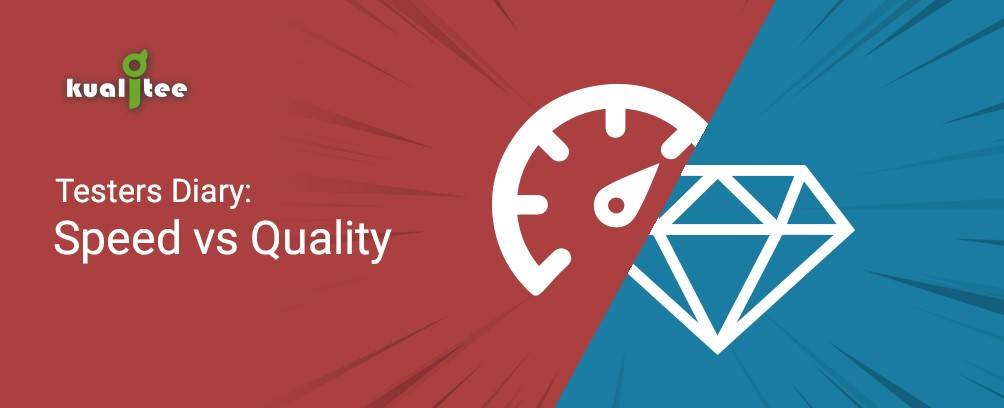Speed or Quality? What’s more important and what can be put in the back seat? Might seem simple to choose, but this teeny decision has taken me by surprise. It’s something every tester deals with every passing day. At the current testing situation, I feel like caught on the horns of a dilemma between speed and quality.
We, as testers, often sacrifice one at the cost of the other, after being compelled to think which can be more vital in the process of application development.
But it depends on who is your client. It is quite obvious that different corporate sectors have different priorities according to their end-users. I have observed that most E-commerce applications focus more on quality. They influence their customers to shop their products and to become their regular users. It’s totally different with the financial and the healthcare sectors.
Applications like Facebook seems very QA-centric apparently. But, the reality is a bit different. It introduces and implements new features to keep its users engaged without investing in the quality. The reason behind this is that perhaps your favorite social media site does not have its own dedicated QA team. Ironically, we can assume that it has developers that create features and users as testers who test any new feature and let the networking app decide on the next booming thing!
Know it, speed is not the only wise strategy!
How are we dealing with Agile and DevOps?
Let’s talk about those emerging IT companies constantly following the iterative approach and adopting DevOps and Agile technologies. With the arrival of these technologies, it can be inferred that they are more concerned about speed rather the very crucial quality. These iterative technologies are legitimately focused on the implementation of new features and their super-fast reach in the market.
But does it look fine in the light of software testing?
If someone asks me or any other tester, I or he would definitely prioritize quality over speed because new technologies are spinning wheels towards Continuous Testing. Practically, it helps in achieving the increased delivery rate without sacrificing the quality.
But it seems like we aren’t ready yet and stuck in a tight spot!
Apparently, we are twisting the quality standards in this fast run of the digital world that is proceeding towards excessive failures, be it applications, OSs, or web pages.
The debate has not ended yet…
In software development, delivery teams are mostly pressurized by their team leads following their clients’ demand to provide the product before the deadline. But as I mentioned above, it varies with the type of industry or client and their demand.
Mostly, this dilemma occurs when testers are asked to work under such burdening circumstances. It is quite likely that I or any other tester would skip some important testing steps just to reach the quick delivery which leads to application failure in the end.
Just a reminder to all the frenzied teams: Cutting corners and leaving the QA process unchecked or even unfinished will eventually cost plenty of time and amount as well.
Just so you know…Even companies like Apple are not doing well in this zone of development, let me quote it for you:
As per Forbes, Apple has given its users a nasty surprise in the form of iOS 11. Seemingly, the company does not skeptically sneak into the riddling glitches. Instead, it floods the Apple users with sporadic updates featuring new bugs as another new treat.
The prominent iOS 11 bugs include troubling UI, stuck auto-correction, apparently drunk Siri (not functioning accurately), and lack of detail in any innovation or change. It’s like it does not matter how frequently Apple updates its iOS, it still hasn’t found a solution to provide an error-free version.
How to Achieve Both Speed and Quality?
Us testers and other project stakeholders, need to get out of the mania and should join heads to devise a better solution. A solution that can combine the speed a developer strives for while maintaining the quality us testers approach crucially.
Point to Ponder: To achieve both agility and renowned reputation, how can we work in a way that is both rapid and error-free?
I know what it takes when I attempt to achieve both parameters in any software development project. I go haywire!
But what I have learned is, there are many ways if you seek…
We have no time to improvise our techniques and guess that it will come out as expected. Instead, why do we not carve out ways that can help leave the debate of Speed vs. Quality? The predicament is that we focus on delivering the product to the client under the provided deadline, but we don’t seek ways to integrate it with both speed and quality.
What’s the benefit of delivering a product before the time when you don’t get all the praise you deserve?
Don’t confuse yourself over it because these following robust ways can assist you with rapid delivery without compromising quality:
- Continuous Testing is the only solution to continuous delivery and Continuous Integration. It lets an IT team function in a way that helps in achieving constant delivery with the sustainable working solutions for an application.
- You should know that QA Testing Tools have proved to be a great accomplice in serving the today’s world development prerequisites. So, make sure your IT team chooses an efficient QA tool like Kualitee for effective defect management remaining under a fixed time schedule.
- Parallel Testing is another key technique used by emerging IT teams in Agile methodologies. It helps in maintaining a potentially beneficial balance between speed and quality. Moreover, you can reduce time spans quite effectively in complicated and time-consuming practices like unit testing, cross-browser testing, smoke testing, and regression testing. Parallel Testing allows testing of multiple applications and sub-aspects of an application consecutively just to decrease the time consumption.
Just the right integration and you are already done with your API and software development cycles!
Let’s just stop debating over speed vs. quality and instead, focus on the idea of how to achieve both speed and quality in real-time. But again, it differs with the case, product, and, of course, the client. It must be your power of decision and management on how to tackle the speed vs. quality dilemma. It’s like knowing the right amount ingredients for a particular recipe.


























